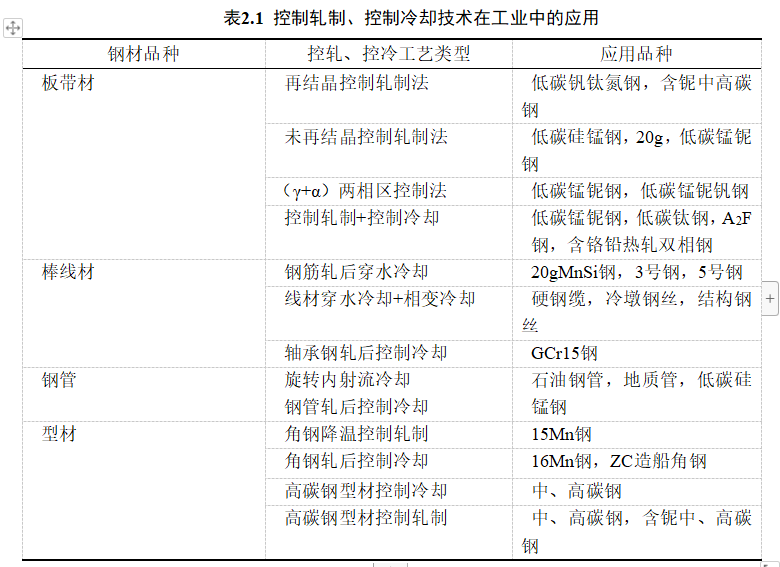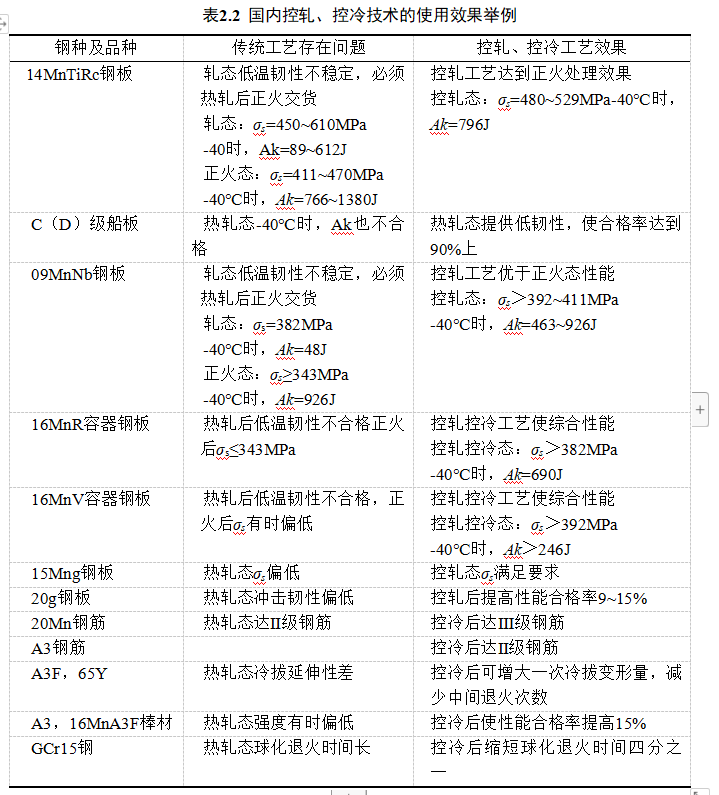Controlled Rolling, Controlled Cooling Technology-1
1.1 Control the rolling process
Controlling the rolling process includes heating the billet to a suitable temperature, controlling the deformation amount and temperature during rolling, and cooling the steel according to the process requirements after rolling. The controlled rolling process is usually divided into three stages, as shown in Figure 1.1 [2]:
(1) Deformation and recrystallization of austenite are carried out at the same time, that is, the roughened γ after the billet is heated shows a work hardening state. This work hardened austenite has the effect of promoting the deformation and deformation of the ferrite phase, making the phase The transformed α grains are fine;

(2) In the deformation stage of the (γ+α) two-phase region, when the rolling temperature continues to decrease below the Ar3 temperature, not only the γ grains, but also the partially transformed α grains will be rolled and deformed, so that in the α grains The formation of subgrains within the grains promotes further refinement of the α grains.
1.2 Advantages and disadvantages of controlled rolling process
The advantages of controlled rolling are as follows: 1. It can improve the low temperature toughness of the steel while improving the strength of the steel. The 16Mn steel medium plate is rolled by ordinary hot rolling production process. Taking the 18mm thick medium plate as an example, the yield strength σs≤330MPa, the impact toughness Ak≤431J at -40℃, and the fracture is 95% fibrous. When a trace amount of niobium is added to the steel, it is still produced by the ordinary hot rolling process. When the controlled rolling process is used, the Ak value at -40 °C will be reduced to below 78J. However, when the controlled rolling process is used. However, when the controlled rolling process is used, the Ak value at -40 °C can reach more than 728J. The α grains of low carbon steel produced under the usual hot rolling process only reach grade 7~8, and the α grains of low carbon steel produced by the controlled rolling process can reach grade 12 or above (according to ASTM standards). At the same time, achieving improved strength and low temperature toughness is a big advantage of the controlled rolling process. 2. It can give full play to the role of trace elements such as niobium, vanadium and titanium. In the production of ordinary hot rolling, the addition of niobium or vanadium to the steel mainly plays the role of precipitation strengthening. As a result, the strength of the hot rolled steel is improved and the toughness is deteriorated. Therefore, many steels have to be delivered after normalizing treatment. When produced by the controlled rolling process, niobium will produce good grain refinement and a certain degree of precipitation strengthening, so that the strength and toughness of the rolled steel have been greatly improved, and the niobium content is very effective. , The vanadium added to the steel has a certain degree of precipitation strengthening and also has a weak grain refinement effect, so it does not reduce the toughness while improving the strength of the steel. Although the titanium added to the steel has the effect of refining the original γ grains during heating, the titanium in the steel cannot play the role of refining the γ grains in the process of rolling deformation under ordinary rolling conditions, and it is still not possible to improve at the same time. The effect of the strength and toughness of the steel, when the controlled rolling process is used to produce the titanium-containing steel, the Ti (C, N) of the steel can play the dual role of precipitation strengthening and grain refinement. 75% of the strength of the titanium-containing steel produced by rolling comes from precipitation strengthening, and 25% comes from grain refinement. Due to the moderate grain refining effect, the low temperature toughness of the steel is improved. Disadvantages of the controlled rolling process: a lower rolling deformation temperature and a certain pass reduction rate are required, thus increasing the rolling load. In addition, due to the requirement of lower final rolling temperature, large-size products need to be warmed between rolling passes, reducing the productivity of the rolling mill. For this reason, countries around the world have begun to carry out technical transformation of rolling mills, adopting heavy-duty rolling mills, installing lifting rollers, and intermediate cooling between passes to reduce the waiting time for rolling and improve the production efficiency of rolling mills.
1.3 Process characteristics of controlled cooling
Advantages of controlled cooling: 1. Save energy and reduce production costs. Using the residual heat of the rolled steel to give a certain cooling rate to control the phase transformation process, which can replace the normalizing treatment after rolling and the quenching and tempering treatment, saving the energy consumption of the secondary heating, reducing the process, and shortening the production cycle. Thereby reducing costs. 2. It can reduce the austenite transformation temperature and refine the room temperature structure. Controlled cooling after rolling can reduce the austenite transformation temperature. For austenite of the same grain size, the α grains will be significantly refined after low-temperature transformation, and the pearlite lamella spacing will be significantly thinner. For example, for a 16Mn steel finish rolled at 800 °C, when the cooling temperature after rolling is increased from 0.5 °C/s to 9.5 °C/s, the average α grain diameter is refined from 12 μm to 7.5 μm, and σs is increased from 360Pa to 420Pa. 3. The carbon equivalent of steel can be reduced. The post-rolling controlled cooling process may reduce the carbon content in the steel and the amount of alloying elements added to achieve the effect of reducing the carbon equivalent. Low carbon equivalent is beneficial to weldability, low temperature toughness and cold formability, which is an economical process route for mass production of industrial steel currently pursued by various countries. 4. Controlled cooling between passes can reduce the waiting time and increase the hourly output of the rolling mill. The use of controlled cooling between passes can precisely control the final rolling temperature and reduce the time for the rolling stock to stop and wait for cooling. During controlled rolling, in order to ensure rolling in the non-recrystallized austenite area, the process of warm rolling is generally adopted, which prolongs the rolling rhythm and reduces the output. In order to less affect the output, the method of cyclic cross-rolling of multiple billets is adopted. Although some remedial measures are taken, it is necessary to build an offline bypass roller table and transfer equipment, which increases the space and equipment. Controlled cooling between passes is adopted, and under the condition of ensuring uniform cooling, the to-be-tempered cyclic rolling can be eliminated. thereby increasing production. For example, when producing 3.0mm thick and 1000mm wide hot-rolled coils, starting the cooling device between the continuous rolling stands can increase the hourly output of the rolling mill from 550t to 720t.
1.4 Control characteristics of controlled rolling and controlled cooling process parameters
Compared with the ordinary rolling process, the process parameter control of controlled rolling and controlled cooling has the following characteristics: 1. Controlling the heating temperature of the billet. The heating temperature of the billet is determined according to the requirements of the steel properties. For microalloys that require high strength and slightly poor toughness, the heating temperature can be higher than 1200 °C. For steels whose toughness is the main performance index, the heating temperature must be controlled below 1150°C. 2. Control the rolling temperature of the last several rolling passes. Generally, the rolling temperature of the final rolling pass is required to be close to the Ar3 temperature, and sometimes the final rolling temperature is controlled in the (γ+α) two-phase region. 3. It is required to give a sufficient amount of deformation in the austenite unrecrystallized region. For microalloyed steel, the total deformation below 900~950℃ is required to be greater than 50%, and for ordinary carbon steel, the accumulation of multiple passes of deformation usually reaches austenite recrystallization. 4. The cooling rate of the rolled steel, the starting rapid cooling temperature, the rapid cooling ending temperature or the coiling temperature are required in order to obtain the necessary microstructure. Usually, the cooling rate in the first cooling stage after rolling is large, and the cooling rate in the second stage varies according to the performance requirements of the steel. The various factors that improve the strength and toughness of rolled and controlled cooling steel are summarized in Table 1-1.



